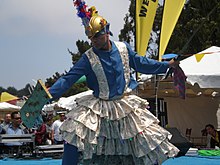Darangen
| Darangen | |
|---|---|
 The Maranaomusical instrument. | |
| Country | Philippines |
| Domains | Oral traditions and expressions; and social practices, rituals and festive events |
| Reference | 00159 |
| Region | Asia and the Pacific |
| Inscription history | |
| Inscription | 2008 (3rd session) |
| List | Representative |
Darangenis a longepic poemof the MaranaoMuslimpeople from theMindanao regionof thePhilippines.It tells stories in 17 parts, with 72,000 lines. One important story is about a famoushero,Bantugan.The word Darangen means "that which is narrated bysongorchant"in the Maranao language.[1][2]
In 2002, Darangen was named a NationalCulturalTreasure by the NationalMuseumof thePhilippines.TheLanao del Surprovincialgovernmentalso called it a Provincial Treasure.UNESCOdeclared Darangen aMasterpiece of the Oral and Intangible Heritage of Humanityin 2008. It's the longestepic poemin thePhilippines.[3][4]
Darangen is usuallysungorchanted.Sometimes,singersperform parts of it duringweddingsandcelebrations.They useinstrumentslike kulintang gongs, Tambor drums, and kudyapistringed instruments.Dancersalso act out different parts of the story. It can last a few hours or even a week. Thepoemalso teaches about Maranaocustoms,values,and practices of both theIslamicperiod and before the Maranao converted toIslamin the14th century.[5][6]
History[change|change source]
The Darangen is a story passed down throughgenerations,not written by a single person. It has 72,000 lines divided into 17 cycles, each telling a different story but connected together. Theepicis written in an old version of theMaranao language.[7]
Skilledsingerscalledonormemorized the Darangen. It was oftensungatnight,duringweddings,or tolullabiesforchildren.A full performance of theepictakes about a week, but shorter performances are more common, lasting a few hours.Singingis accompanied by traditional Maranaoinstrumentslikekulintang gongensembles andTambor drums.[8]

The Darangen mostly reflects thebeliefsof the Maranao people before they becameMuslim.Heroesin the storyworshipand interact with ancestorspiritsandnaturespirits. For example,Batara-sa-Marudo,anaturespirit who can controlfloodsandstorms.[9]
The main setting of theepicis the city of Bembaran, once a grand city near ariver.It's said to have vanished into thesea.The story also talks about relationships between the Maranao people and other groups like the Manobo and the Sama-Bajau.[1]
In written form[change|change source]
The Darangen was only in form ofchantsandsongs.AnAmericanmissionaryandteacher,Frank Charles Laubach, found its value in 1930. He was amazed when Maranao leaderssangit during aboatjourney. Laubach decided to write down theepic.He met anoblemannamedPanggaga Mohammadwho helped him. Laubach published part of the Darangen in1930,making it the first time Maranaosongswere written inLatin letters.[10]
When you pass by the houses of the Maranaws at night, you can hear them singing folk songs or reciting poems that are beautiful and strange. Yet on account of the absence of a Maranaw writer, Maranaw literature has remained in the dark for other people. It has become something of a tale that other Filipino tribes hear only from visitors to Lanao
— Frank Charles Laubach,[11]
Laubach's version was not complete. Later,scholarsfromMindanao State Universityworked on it. They gathered different parts and versions from Maranaoeldersand handwrittenbooks.It took them ten years. From 1986 to 1988, they published the wholeepicin eight books, in bothMaranaoandEnglish.[12]
Folk dances[change|change source]

Dancesrelated to the Darangen include:
- Kaganat sa Darangen:Thisdancetells the story of Prince Lomna's journey to proposemarriage.Dancers move gracefully, using fans, and sway theirfingersandhips.[13]
- Sagayan:This is awardance that shows Prince Bantugan preparing forbattle.It's sometimes called Kasagyan.[14]
- Singkil:In thisdance,dancers usebamboosticks, clashing them together. It portrays theabductionof Princess Gandingan and her rescue by Prince Bantugan. It's also known as Kasingkil or Kasayaw sa Singkil.[15]
References[change|change source]
- ↑1.01.1Saber, Mamitua (1961)."Darangen: The Epic of the Maranaws".Philippine Sociological Review.9(1/2): 42–46.ISSN0031-7810.
- ↑"HUDHUD AND DARANGEN: VOICES FROM PRE-COLONIAL PHILIPPINES".UniPro | Pilipino American Unity for Progress, Inc.2015-07-23.Retrieved2024-02-09.
- ↑"UNESCO - Darangen epic of the Maranao people of Lake Lanao".ich.unesco.org.Retrieved2024-02-09.
- ↑"Unesco proclaims Maranao's Darangan epic as 'masterpiece of intangible heritage'".Philstar.Retrieved2024-02-09.
- ↑"PnoyAndTheCity: A center for Kulintang - A home for Pasikings: The Art of Trickling".Retrieved2024-02-09.
- ↑Darangen: In Original Maranao Verse, with English Translation.Folklore Division, University Research Center, Mindanao State University. 1995.ISBN978-971-11-1120-5.
- ↑Readings in Philippine Literature.Rex Bookstore, Inc. 1994.ISBN978-971-23-1564-0.
- ↑Jacinto, Joelle Florence Patrice (2018-07-02)."A UNIVERSAL EMBODIMENT OF THE HERO: Translating the Darangen as a Ballet".Journal of English Studies and Comparative Literature.15(1).ISSN0119-1721.
- ↑"Darangen, The Maranao Epic – ICH Courier Online".web.archive.org.2019-12-26. Archived fromthe originalon 2019-12-26.Retrieved2024-02-09.
- ↑Eugenio, Damiana L. (2007).Philippine Folk Literature: An Anthology.UP Press.ISBN978-971-542-536-0.
- ↑Madale, Abdullah T. (1997).The Maranaws, Dwellers of the Lake.Rex Bookstore, Inc.ISBN9789712321740.
- ↑Gowing, Peter G. (1983)."The Legacy of Frank Charles Laubach".International Bulletin of Missionary Research.7(2): 58–62.doi:10.1177/239693938300700203.ISSN0272-6122.
- ↑Casanova, Arthur de la Peña (2001).Diksyunaryo sa drama at teatro(in Tagalog). Rex Bookstore, Inc.ISBN978-971-23-3084-1.
- ↑Madale, Abdullah T. (1997).The Maranaws, Dwellers of the Lake.Rex Bookstore, Inc.ISBN978-971-23-2174-0.
- ↑"The Traditional Dance Of Lanao Del Sur, On The Spotlight In Teleserye Wildflower - Choose Philippines - Authentic Filipino Experiences".web.archive.org.2019-11-28. Archived fromthe originalon 2019-11-28.Retrieved2024-02-09.
